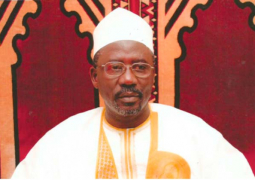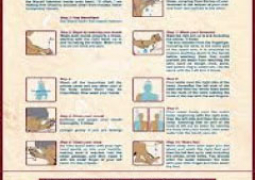
Jabir reported: “The Prophet, peace be upon him, forbade the whitewashing of a grave, sitting on it, or erecting any structure on it.” (Reported by Ahmad, Muslim, Nasa’i, Abu Daw’ud, and Tirmizhi who said that it is a sound hadith) Tirmizhi reported this hadith with this wording:
“The Prophet, peace be upon him, forbade the whitewashing of graves, writing on them, building on them, or stepping on them.” Nasa’i, reported it in these words: “The Prophet, peace be upon, forbade building over a grave, adding anything to it, white washing it, or writing on it.”
The majority of scholars interpret this prohibition as an expression of disapproval, while Ibn Hazm takes it to mean that the act is unlawful. The wisdom behind it is that a grave is not made to last forever, but is sure to disintegrate with the passage of time. Whitewashing graves is decorating them with the beauty of this world for which the dead have no need. Others think that its wisdom lies in the fact that whitewashing is done by burning gypsum (brimstone): This view is supported by a narration of Zaid bin Arqam who said to a person who wanted to build something over his son ‘ s grave and whitewash it: “You are wrong and have done a useless thing. Nothing touched by fire should be brought near the grave.” There is nothing wrong, however, in daubing it with clay. Tirmizhi said: “Some scholars, including Al-Hasan al-Basri, hold it permissible to coat the graves with clay.” Ash-Shafi’i is also of the same view and sees no harm in giving the graves a coating of clay.
Ja’far bin Muhammad reported from his father: “The grave of the Prophet, peace be upon him, was raised one hand from the ground and was coated with red clay and some gravel.” This was narrated by Abu Bakr An-Najjad, but Al-Hafiz did not comment on this in his Ai-Talkhis.
The scholars also disapprove of building graves with bricks or wood or burying the dead with a coffin unless the burial ground was wet or soft. If it is wet or soft, then it is permissible to use bricks and the like and to place the body in a coffin. It is reported from Mughirah that Ibrahim said: “The scholars preferred bricks of clay and straw, but disliked clay bricks; they preferred bamboo and disliked wood.” Concerning the hadith prohibiting writing on graves, it apparently includes writing the name of the deceased or any other thing on the grave. Al-Hakim commented on this hadith and said: “Though its chain of narrators is sound, in practice, however, it was not followed.” Many Muslims from the East and the West do write on the graves. This is a practice that was passed on from one generation to the next. Azh-Zhahabi said: “This hadith is an innovated one, and no prohibition is genuinely reported.” The Hanbali school holds that inscription on graves is prohibited, whether it is a portion of the Qur’an or the name of the deceased.” The Shafi’i school agrees with this ruling, but they also hold: “If the grave is of a scholar or a righteous man, it is preferable to write his name on it to make it known.” The Maliki school holds that writing any portion of the Qur’an is not permissible, but writing the name and date of death of the deceased is disliked (Makruh). The Hanafi School disapproves of writing anything on the grave and considers it unlawful, except when it is feared that any trace of the grave might disappear. Ibn Hazm said: “It is not disapproved if the name of the deceased was engraved on a rock.” It is forbidden in a hadith “to add more soil than what was taken out when digging the grave.” Al-Baihaqi has dealt with this under a separate chapter entitled, “No adding of soil to the grave in excess of what is taken therefrom.” Ash-Shawkani said that: “Adding apparently here means adding more soil than what was taken out while digging the grave.” Some interpreted the addition to a grave as making a grave over another one. Ash-Shafi’i preferred, however, the first interpretation, saying that it was preferable not to add more soil than what was taken out while digging the grave which is preferred lest the grave be raised high. So long as the additional soil does not raise the grave higher than the ground, there is nothing wrong with it.
Burying More than One Body in One Grave
From the example of early generations, we learn that one body is to be buried in a grave. It is disliked if more than one body is buried in a grave, unless there is a large number of corpses, and there is a scarcity of graves, and it is impossible to bury them separately. In such a case, it is permissible to bury more than one body in a grave. This is based on a hadith reported by Ahmad and Tirmizhi, who said, “The Ansar came to the Prophet, peace be upon him, on the day of the Battle of Uhud, saying: ‘O Allah’s Messenger! We are afflicted with physical injury and we are tired, what do you command us to do?’ The Prophet, peace be upon him, said: ‘Dig it, enlarge it, and deepen it, then place two or three men in one grave.’ They asked: ‘Whom should we put in first?’ He said: ‘The one who knows the most Qur’an’.” Tirmizhi stated that it is a sound hadith. ‘Abd-ur Razzaq reported from Wathilah ibn al-Asqa’ with a sound chain of narrators that, “a man and a woman were buried together in the same grave. The man would be placed first, and then the woman behind him.”
Burial at Sea
The author of al-Mughni said: “If a person died while in a ship on the sea, then, according to Ahmad, they should wait a day or two to find a place to bury him, unless they are afraid that the corpse would decay. If they cannot find a place (on land) to bury him, then the deceased should be washed, shrouded, a funeral prayer offered for him, then tied with a heavy weight, it be thrown into the water.” This is the opinion of ‘Ata and Al-Hasan. Al-Hasan said, “He is to be put in a basket and then thrown into the sea.” Ash-Shafi’i said: “The body should be placed on two boards and let into the sea so that the boards might take it ashore, where some people might find it and bury it. But if one throws it into the sea, one would not be committing any sin.” The latter, i.e. burial at sea, is preferable, because it serves the purpose of covering the body which is comparable to burying him. Tying it between two boards is apt to expose it and cause it to be disfigured and mutilated. It might be thrown on the shore, mutilated and naked, or it might fall into the hands of pagans. That is why we believe the second course mentioned above is to be preferred.
Placing Branches of Palm on a Grave
It is not lawful to put a branch of a palm or flowers on a grave. The contrary is suggested by the following hadith reported by Bukhari and others from Ibn ‘Abbas: “The Prophet, peace be upon him, passed by two graves and said, ‘Those two are being punished for a minor matter. The first did not clean himself carefully after urinating. The second one used to spread lies.’ Then the Prophet, peace be upon him, asked for a fresh branch of a palm tree, broke it into two parts, and then placed a part on each of them, saying, ‘I hope that this will reduce their punishment for as long as the branch remains fresh.’ Al-Khattabi is of the opinion, however, that “This placing of a branch of a palm on the graves, while saying, “I hope that this will reduce their punishment for as long as it remains fresh,” is a blessed effect of the Prophet, peace be upon him, and of his supplication to Allah to lighten their punishment. “According to Al-Khattabi, “He hoped, as it were, that the two would be relieved of their punishment so long as the palm branch remained fresh. This, however, does not have anything to do with the freshness or dryness of the palm branch or its role in lightening the punishment as such. Though the masses in many of the Muslim countries place branches of palm over the graves of their relatives, this practice has no basis or merit in the light of Islamic teachings.”
Al-Khattabi’s opinion as reported above is correct. The Companions of the Prophet, may Allah be pleased with them, were familiar with this and practiced it. Bukhari reported that, “There is no evidence to show that anyone of them ever put a branch of a palm or a bunch of flowers on graves, except on the grave of Buraidah al-Asalmi, who had instructed his heirs in his will that two branches of palm be placed on his grave.’’ (Bukhari) The idea that such a practice was lawful, and yet was unknown to all the Companions, except Buraidah, is not plausible. Al-Hafiz said in Al-Fath: “Apparently Buraidah took the hadith in its general import and did not regard it as specifically related to those two men.” Ibn Rashid said: “It is apparent from Bukhari’s commentary that it was specifically done by the Prophet, peace be upon him, for those two men. He also quoted a statement of Tbn ‘Umar, who, when he noticed a tent was set up over ‘Abd ur Rahman’s grave, said: ‘Take it away; the only thing that can shade him is his deeds’.” Ibn Umar’s statement shows that he realized that placing anything over a grave does not benefit the deceased, except his own good deeds.
To be continued





